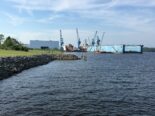BATH – The U.S. Navy is seeking a 10-year permit from the U.S. Army Corps of Engineers to dredge portions of the Kennebec River from Bath to Phippsburg to allow the passage of destroyers built at Bath Iron Works.
The Navy expects maintenance dredging will be needed every three years, according to a statement.
The first dredging would happen next winter and would move 80,000 cubic yards (roughly the volume of 20 Olympic-size swimming pools) of sand and sediment from the bottom of the Kennebec between Bath and Phippsburg, particularly in shoal-prone areas. Shoals are large formations of sand that accumulate on the bottom of the river.
Up to 50,000 cubic yards will be removed from Doubling Point and dumped in the river near Bluff Head to make the area around Doubling Point 31 feet deep. At the river mouth, up to 20,000 cubic yards will be removed to make the river 29 feet deep, with the material disposed of near Jackknife Ledge. Both disposal sites have been used repeatedly in previous dredging projects.
The dredging process takes approximately a month to complete, using a hopper dredge and/or a mechanical dredge. The U.S. Army Corps of Engineers did not disclose how much the process costs.
These dredging ensures the Kennebec is deep enough so military vessels made at BIW can move downriver to open ocean. BIW’s most recently christened Arleigh Burke-class destroyer, the future USS Daniel Inouye, will leave the Bath shipyard in 2020 for Pearl Harbor, Hawaii.
Tim Dugan, a spokesperson for the U.S. Army Corps of Engineers, said that portion of the Kennebec River federal navigation channel is “authorized by Congress to be so wide and so clear. … (BIW) needs to release those ships in a timely fashion. They need those areas of the river free and clear of debris.”
Eleven Arleigh Burke-class destroyers and one Zumwalt-class are under contract for delivery from BIW in the next 10 years.
A BIW-built Arleigh Burke class-destroyer has a draft of about 30 feet, and a Zumwalt has a draft of 27.6 feet.
BIW spokesman David Hench referred questions about the dredging to the Navy, but stated in an email: “Maintaining a navigable channel in the Kennebec River is necessary for safe passage of ships and is essential to our business and our Navy customer’s goal of delivering the quality ships it needs for the nation’s fleet.”
The 2017 dredging was an “emergency” dredging, needed to allow the USS Rafael Peralta, an Arleigh Burke-class destroyer, to depart from Bath, according to previous reports. Shortly before the ship’s departure, it was discovered that the ship couldn’t navigate the river, even at high tide.
The Navy acknowledged the impact dredging the Kennebec River poses to the river’s ecosystem. In a news release, the U.S. Army Corps of Engineers said the Navy is consulting with the National Marine Fisheries Service.
Colleen O’Rourke, a Navy spokesperson, said, “Both the Navy and Army Corps of Engineers are very concerned about the environmental impacts of the dredging. As required in the permitting process, we extensively coordinate with both federal and state environmental agencies to ensure that all requirements are met.”
The Army Corps outlined turbidity as one potential problem for species living in the river because it decreases both visibility and the amount of light able to pass through the water.
“The impacts will be minimal and of short duration,” Dugan said.
David Grey, chairman of the Phippsburg Shellfish Commission, said, “We’re totally fine with them dredging, we support BIW, as long as they don’t do it in the summer when the shellfish are seeding.”
Grey said when the river is dredged during the spring and summer, “the shellfish are more or less suffocated” when the dredged material is deposited in harvest areas in Phippsburg.
The Army Corps issued a public request for public comment, as required by the Clean Water Act of 1977. Comments should be submitted in writing to Nick Livesay, director, Bureau of Land Resources, Department of Environmental Protection, 17 State House Station, Augusta, ME, 04333-0017 or tomick.livesay@maine.gov.
Send questions/comments to the editors.



Comments are no longer available on this story